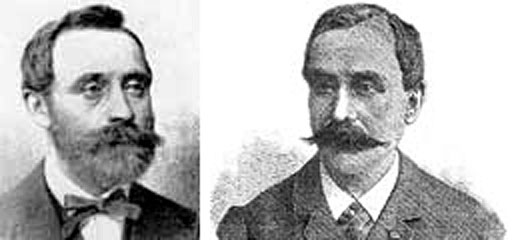When we uncover new images of historical harp guitar players, I’m always curious about whether the old photo or postcard is of some nameless amateur or unknown performer, or whether it could turn out to be a “known” historical figure whose image has eluded us. It is rare indeed when a fascinating photo can be linked to a known player, like in this case:
![]()
When I obtained this gorgeous rare photo, I asked those on the private Guitar Summit Forum (the world’s early guitar music experts) about it. After little interest (and a surprisingly cavalier non-answer from the infamous Matanya Ophee: “Your best bet for identifying the time and place (of the photo), would be to consult specialists in wicker furniture or terrazzo flooring.”), Françoise de Ridder was kind (and bold) enough to suggest that the 11-string was possibly by the obscure firm, “Hijos de Gonzalez” (Sons of Francisco Gonzalez) of whom they had some experience.
Next, forum member Jun Sugawara identified the player as Carlos Garcia Tolsa (1858-1905), with the help of Randy Osborne’s listing on Fine Fretted String Instruments.
Those moments are pretty exciting, and, I think, important for all of us.
So I was very excited the other day when a fellow named Chad Pepin, a guitar student at Central Washington U., called to tell me that he had identified one of the unknown harp guitar players in the Iconography section.
Passionate about the music of Johann Dubez, whose two known 10-string pieces, Conzert-Polonaise componirt für die 10 saitige Guitarre and ”Erinnerung an Bucarest”: Conzert-Potpourri fûr die 10-saitige Guitarre, he considers the most musical of all the multi-string composers’, Chad has done extensive Internet searching on Dubez (seen in the 2 known images below).

![]()
When the search led him to Harpguitars.net, he browsed all the Iconography pages, and was struck by the image at left. He was convinced it was Dubez, and with a 10-string Scherzer guitar. Alas, when I compared the images, I couldn’t see anything beyond a vague similarity. I’m pretty sure the man is not Dubez, how about you? Neither does the instrument remotely resemble a Scherzer. So, with apologies to Chad, thanks for checking – I hope you turn more up, and I hope you can obtain that 10-string one day to play this music!
But the mistaken identity image that keeps on going (and going, and going) is the infamous Knutsen-playing “Sombrero guy.”

This wonderful 3-shot photo is a prize of John Doan’s collection. I made the mistake of captioning it with “(and no, it’s not Groucho Marx)” A couple still think it Groucho, with one convinced. Our old pal Dan’l Terry (once a builder of harp guitars) used his “face recognition software” to prove that it was Groucho “with a ~95% certainty factor.”
I think he finally caved in, since, dubious about the software or not, as an obsessive Marx Brothers researcher since High School, I’ve probably seen 99% of every Groucho photo ever published – and can tell you with certainty that (to paraphrase Senator Lloyd Bentsen) “I know Groucho. And ‘Sombrero Guy’ is no Groucho.”
And people are still guessing. One of my close associates asked recently, “Why aren’t you divulging who the player is when it’s known?” Confused, I said, “but it’s not Groucho – who are you saying it is?”
![]()
“Rudolph Valentino…I’d seen the triple photo listed as being Valentino in an old book about silent film stars. The book had no connections to lutherie or HGs, so I thought I could trust it as an impartial source. Perhaps the person doing that captioning was also fooled by the costume? Who knows.” Huh? I Googled and scoured a whole pile of photos of the silent screen legend (who by complete coincidence was actually in a film with a Dyer player!), and I don’t see any resemblance – other than maybe the costume looks like something out of one of his period pictures.
Hey, I’m thrilled that folks continue to try to I.D. these various mystery players. But as I said, “Close, but no (Groucho) cigar…”
Or:
“Valentino? That’s the most ridiculous thing I’ve ever heard.” (Tip: Pronounce last as in “hide” not “hoid” for best impersonation)







Regarding the so called “Sombrero Guy” he is definitely not Groucho Marx. I have other photos of him without an instrument from various angles which show he is someone else. Several of the photos have handwriting signed “B A Reade” and under the name is “Seattle”. He is either a vaudeville performer whose pictures were taken by B A Reade of Seattle or he is B A Reade of Seattle. The Spanish costume was not uncommon for the Vaudeville stage. I have other photos of harp guitarist stage personalities in “The Three Masquiera Sisters” and the “Mexican Musical Monarchs” from Spokane, Washington as well. They all appear to be colorful performers from an era we still know little about.